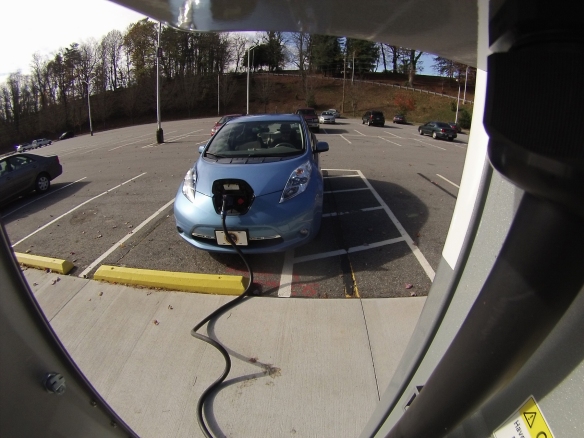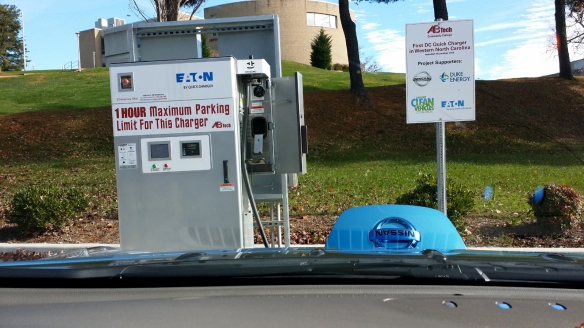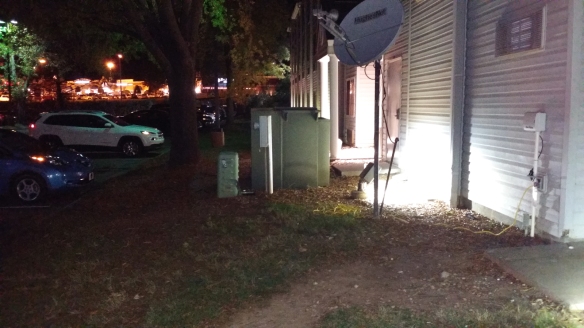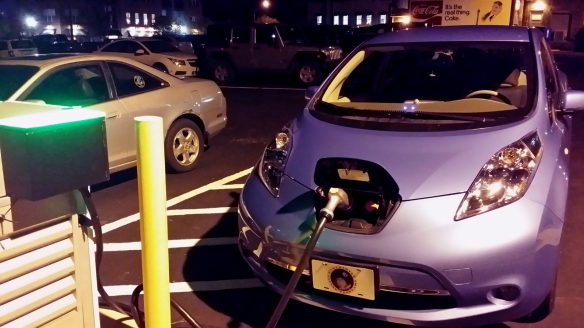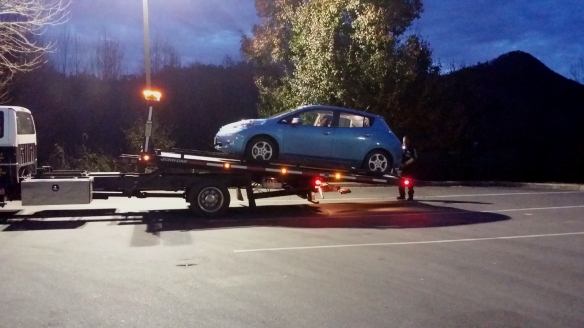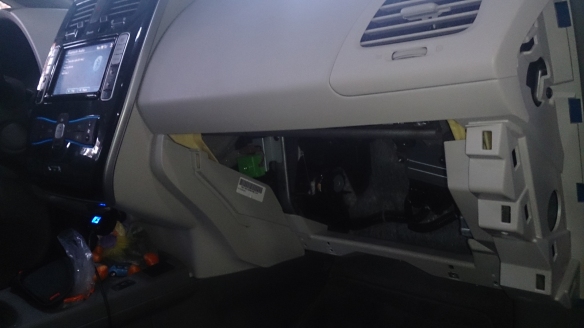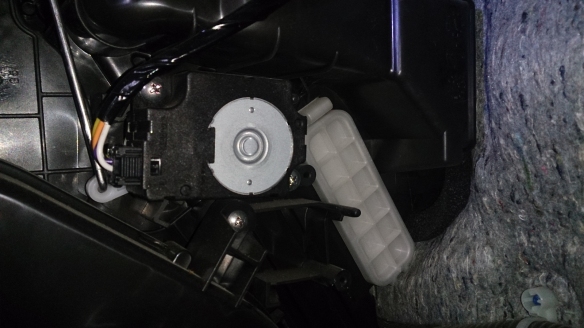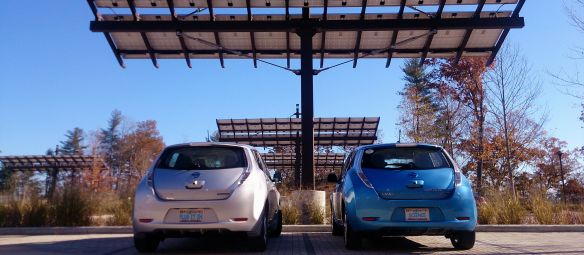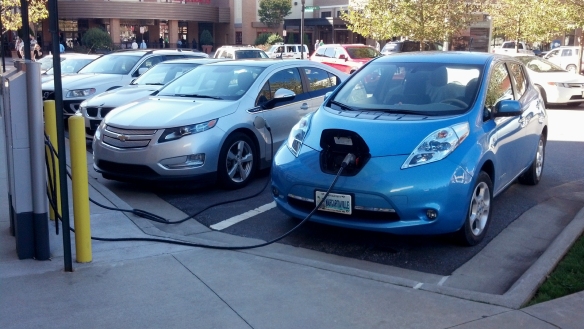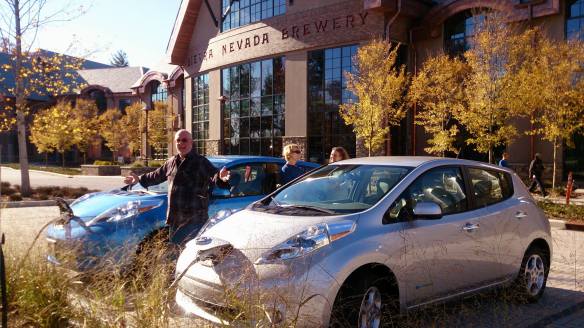
The author’s 2012 Nissan Leaf EV “plugged in” at a local solar farm.
In response to a recent, somewhat negatively pitched report by WLOS News 13 in Asheville, North Carolina (see the article here http://www.wlos.com/news/features/top-stories/stories/Electric-car-sales-don-t-hit-initial-goal-246626.shtml#.VofUP_krJhF ) and the ensuing wave of negative public comments in regards to the technology…
I offer just the facts on EV’s from the point of view of an EV owner of 2.5 years.
FACT: In 2013 I purchased a one year old 2012 Nissan Leaf (100% electric car) with 1,200 miles on the odometer. I have now driven the Leaf over 33,000 gas free miles. UPDATE as of 6/21/17: I have now driven the Leaf over 50,000 miles.
FACT: I drive it daily to work and back in all weather, on paved and gravel roads, and up and down the mountains we call home. I drive it an average of 40-45 miles/day and more on weekends. Due to the wonderful and growing EV charging network that continues to expand and open the roads to EV drivers – I can go almost anywhere in the WNC/Upstate SC/East Tennessee areas with no problems.
A GE charging station in Black Mountain, NC.
MYTH: It is very expensive to charge an EV.
FACT: Just the opposite. It costs me an average of $.89/day – close to $7/week in electricity to drive the EV around 300 miles/week. When charging at community EV charging stations (level 2 and 3) I usually pay around $2 – $6 to fully charge my Leaf and many of these stations are in fact…free. Many of these stations are also solar powered so some of my electric fuel is solar generated and my EV is then solar driven and fully zero emission! Learn more at www.brightfieldts.com
FACT: Even when I account for the cost of electricity over the last 2.5 years – I have still saved close to $3000 that I would have spent on gas and oil had we continued to drive two gas powered cars.

Charging the Leaf in downtown Salisbury, NC on a recent road trip.
MYTH: EV’s have very short range, will run out of “juice” and leave you stranded.
FACT: While the currently available EV’s do have limited ranges varying from around 70 to 300 miles on one charge – like most newer Internal Combustion Engine (ICE) powered vehicles they have alert systems to let you know when your fuel level is getting low. They also have sophisticated GPS connected navigation systems that allow you to plan your trip ahead of time taking into account stops at charging stations along the way.

The Tesla Model S interior
While it is understandable that this lifestyle is not for everyone, advances are being made daily in the EV, battery, and charging infrastructure that, within a few years time, will put 200 to 300+ mile range capable EV’s on the roads from start-ups to most of the world’s major auto makers that are now revealing some incredible new transportation technologies to the world such as the Nissan IDS concept, Tesla Model X, Model 3, Model Y, Tesla Pickup and Semi, Chevrolet Bolt, Workhorse pickup, Via motors, and the incredible and out of this world Faraday Future and many others that will hopefully lead to who knows what kind of amazing EV’s, and maybe one day an Apple EV and even an Electric-Corvette!
No matter if you run out of a charge or if you run out of gas – it is your fault for not planning ahead as I found out recently in the blog post just before this one.

A Tesla Model S charging.
MYTH: “Electric Vehicles are not zero emissions, they run on coal, and are dirtier and more polluting than internal combustion engine (ICE) powered vehicles that run on gas/diesel fuel.”
Let’s break it down…get ready because this is detailed.
FACT: Battery Electric Vehicles BEV’s (the focus of this report) do not run on anything but electricity and are themselves – zero emission. That being said, depending on how that electricity is generated– the place it gets its electricity–could be “dirty” (coal) or “clean” (renewable energy) but in most places it is a combination of both so let’s dig deeper.
FACT: A small ICE car emits ~390 grams of Carbon Dioxide CO2/mile.
FACT: The average power consumed by a small EV is ~.25 KWh/mile.
FACT: ~907 grams of CO2/KWh is emitted from coal fired power plants in the dirtiest 100% coal-based electricity generation areas.
FACT: 907 (g) x .25 (KWh) = 226 grams/mile in dirtiest 100% coal-based electricity generation areas, which remains lower than the 390 grams from the small ICE car so in reality, even if your EV is charged in an area that gets all of its electricity from coal, EV’s are still cleaner than a comparable ICE powered vehicle.

The amazing BMW i3 EV
MYTH: Building more EV’s will require us to build many more power plants to provide all the electricity to operate all of them.
FACT: EV’s are charged from the same utility grid that your mobile devices use. Like your devices, EV’s come with their own charging cable that plugs into a standard electrical outlet found on the outside of your house. Like most of your mobile electronic devices they are usually charged at night, while you are sleeping, and when electricity generated from emissions free wind and hydro power is in low demand, lower in cost, and goes mostly unused – so there is ample supply to power your EV. For those opposed to plugging in (or the busy, lazy and/or forgetful types) now in development are inductive charging highway lanes that, when you need a charge, you will just simply drive in the lane and your car will charge while moving at speed! There are also currently available inductive charging pads (just like you can buy for mobile devices) but made for select EV’s. This will eliminate the need to plug in your EV at home and possibly one day you will even be able to just park in an EV charging parking space and your car will automatically start charging as you walk away.
FACT: The US power grid is getting cleaner every day as more fossil fuel fired power plants are retired and more renewable energy power systems go online – so in these areas especially, EV’s are much cleaner.
FACT: Due to the fuel mix of the grid getting cleaner, EV’s get cleaner as they age. This is never a fact with ICE cars that constantly loose efficiency as they age due to wear and tear.
Learn more here:
www.greencarreports.com/news/1086927_coal-makes-electric-cars-bad-no-plug-ins-show-coal-as-worse
and from the Union of Concerned Scientists
The updated numbers as of May 2017 reveal that, as predicted, EV’s are getting cleaner in response to a greening power grid; http://blog.ucsusa.org/dave-reichmuth/new-numbers-are-in-and-evs-are-cleaner-than-ever

Three Nissan Leafs, A Chevy Volt, and a Tesla Model S charging at the BrightfieldTS solar canopy charger in downtown Asheville, NC.
FACT: One parking space covered with a canopy of photovoltaic solar panels (2.5KW) in the southeast would produce around 3,292 KWh/year. This will operate an EV for around 13-16K miles of 100% emissions free driving on clean, sunshine generated electricity!

The owner’s Leaf on the right and another local Leaf charging at the Sierra Nevada Brewing Company’s solar powered EV charging station in Mills River, NC.
FACT: EV’s produce a portion of their own fuel via the process known as regenerative breaking – try to find an ICE powered vehicle that does that!
FACT: The average EV travels an average of 4 miles/Kilowatt hour (KWh) of electricity.
FACT: It takes 6 KWh of electricity to refine one gallon of gasoline (source US DOE).
FACT: The average EV can travel 24 miles on the power that it takes to refine just one gallon of gasoline!
FACT: It takes ~9 KWh of energy to extract and transport the crude oil that will be refined into that gasoline.
FACT: An EV could travel an additional 36 miles on this energy.
So, no new power plants are needed, especially if we do not produce the gallon of gas. So…get an EV, and drive 60 all-electric miles on the same amount of energy we are generating today to refine all that dirty gasoline…
And…
Save the 44 gallons of water that it takes to refine that one gallon of gasoline! It is a no-brainer.

The extention cord is the new “jerrycan.”
While anyone with a purely electric vehicle will tell you that good trip planning is essential for anyone owning a fully electric vehicle, you just never know what may happen out there on the road. Back in the days before electric vehicles I would always carry a small plastic “jerrycan” just in case I ran out of gas. Today, I always carry a 100′ heavy duty extention cord in my EV for the very same purpose. Good thing for those of us that drive 100% electric vehicles, there are thousands of dedicated charging stations in most cities across the USA and the world however, in between those EV chargers there are also millions of standard 110v electric outlets everywhere you will find people and their buildings.
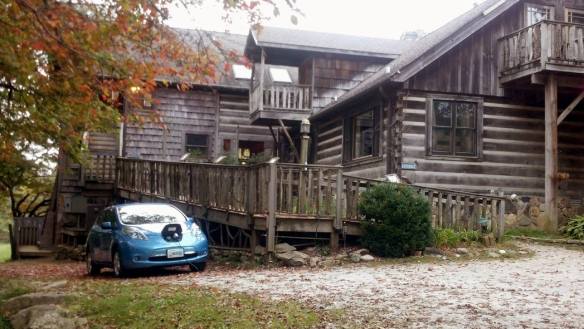
Charging at Earthshine Discovery Center in rather remote (for EV’s) Lake Toxaway, NC
These outlets and their electricity can be accessed in emergencies…with permission of course. That said, I have only had to plug into a handfull of outlets due to a low battery charge since owning the Leaf–one of the first being on day one of Leaf ownership…I was such a greenhorn :-)…and most recently on a road trip I covered in this blog posting.

Trickle charging at the SmokyQ BBQ in Marion, NC.
When I have had to do so, most of the people that have granted me access to their outlets have been very friendly, very interested in EV technology, and have freely offered some of their electricity. In return I have always left them a generous tip for the use of their electricity and their time. In almost every instance the most valuable thing I have driven away with is not the electricity, but the friendly conversation with an individual I would have never met if not for my EV. I offer the below recent video as an example.
In fact, many EV owners including myself, list their homes and businesses on Plugshare.com as residential EV charging locations. They do this in support of other EV drivers that may be close to the end of their vehicle’s range and need a charge to get to the next high power charging station and they do this to be part of the rapidly growing community of like-minded, forward thinking EV owners who see a brighter, cleaner, fossil fuel free future on the horizon for us all.
MYTH: It is very expensive to power an EV.
FACT: The average cost of electricity in the US is 12 cents/kWh. Therefore the average person driving an average EV 15,000 miles per year will pay about $540.00 per year to charge it. Personally I spend less than $300/year on electricity to fuel my Leaf…how much did you pay for gasoline/diesel last year?
I bet it was much more than that.
Think about what could you have done with all that extra money you spent on gas and oil? Just think about it…or remain in denial of the facts. It is your choice.
FACT: Believe it or not – five 100 watt light bulbs left on continuously for a year use nearly the same amount of energy as it takes to power an electric car 15,000 miles! Here’s how: Five 100 watt light bulbs use 500 watts. In 24 hours they use 12,000 watt-hours or 12kWh. In 365 days they use 4,380kWh. A typical EV that uses 30 kWh for every 100 miles will use 4,500 kWh to drive 15,000 miles! Simply by turning unnecessary lighting off at your home, you can drastically reduce or completely eliminate your annual transportation fuel cost. Try doing that with an ICE powered vehicle! (The cost of LED lighting products has dropped recently so we have replaced almost all of our light bulbs in our house with LED’s. This has not only saved us money but we have also totally offset the cost of driving our Leaf EV!)
Learn more here: www.pluginamerica.org/drivers-seat/how-much-does-it-cost-charge-electric-car
Cars are not the only way you can reduce emissions by switching to EV’s

“Coal Rolling” photo found online…cough, cough…
FACT: One piece of gas burning lawn equipment emits more hydrocarbon pollution into our shared atmosphere than a gasoline-guzzling crew-cab pickup truck! You would have to drive a 6.2L V8 truck almost 4000 miles to equal the emissions produced in 30 minuets of use by a gas powered 2-cycle engine such as a string trimmer (weed-eater). Why not use an all electric string trimmer or lawn mower—there are many available now and they all can even be fueled with renewable energy you can generate at home!
UPDATE 6/21/17: Since I wrote this article many companies have introduced all electric lawn equipment such as the Ego backpack leaf blower and the Husqvarna Auto Mower and many others. Electric vehicles are quickly and quietly taking over the world and that is a very good thing!
MYTH: EV’s, solar, wind, and other renewable power sources are not American because they do not create jobs or use the oil/gas that we fight deadly wars to acquire.
FACT: The Nissan Leaf EV is made in Smyrna Tennessee and provides over 300 American workers with excellent jobs. Tesla provides around 6000 Americans jobs now and will employ 12,000 after the Gigafactory goes online. The number of employees working in the solar industry has more than doubled in five years and today there are now over 200,000 Americans working in solar. Believe it or not, there are now more people working in solar than in gas and oil fields and that’s almost three times the size of the entire coal mining industry…the carbon bubble is bursting. The wind energy industry provides great jobs to over 70,000 Americans and clean power to over 18 million homes. And that’s just for starters…companies like Solar City and Arcadia Power are changing the way we acquire our energy at home from renewable energy providers.
FACT: Sourcing our energy domestically (be it solar, wind, hydro, coal—whatever the source) provides many good jobs to Americans and is much more efficient and much safer than traveling thousands of miles, dealing with foreign governments that are often hostile and feed terrorism groups, extracting the crude oil, then finally bringing it back home to be refined and used…often at great cost and loss of life due to the wars that often must be fought to keep it flowing.
FACT: It is more American to be self sufficient and produce your own energy at home, than it is to rely an outside source to provide you with that energy.
FACT: You can power your home and your EV with off-the-shelf renewable energy (solar, wind, hydro, etc ) that you produce at home…and even make a profit from the excess!

A solar powered home in Asheville with a monthly power bill of less than $20!
MYTH: EV’s are expensive to work on.
FACT: While it is no secret that EV’s have many similar systems as ICE powered vehicles such as braking, steering, suspension, heating etc. However, EV’s rarely need major servicing on their drive systems due to the simple fact that they have far fewer moving parts in their power plant whereas the average ICE engine has thousands! Therefore, EV’s require far less maintenance to keep them “healthy” and are therefore much more economical to drive.
I have been driving my Leaf now for over 33k miles and the little EV has required no specialized routine maintenance by me other than the occasional washing and vacuuming, a set of new windshield wiper blades, adding a little air to the tires, and the occasional topping off of the washer fluid – you know, the things you would need to do to any type of vehicular construct no matter its fuel source.
Recently, I had to replace the cabin air filter. By replacing the filter myself I saved around $50 labor cost (as quoted by my local Nissan dealership)!
Costs: $35 for the filter and about an hour of my time. This is not that bad considering this is the first in-depth preventative maintenance (that was not covered in the warranty*) that I have completed on the car…in 33k miles! Had this been a gasoline/diesel powered vehicle I would have had to spend far more time and money over the same 30K mile time-frame. For example, to keep my 1999 Toyota 4Runner “Godzilla”, my only remaining ICE vehicle that I keep only for long range trips and hauling large loads, running in an efficient as possible manner (for a machine with so many miles – 200+k – and so many moving parts that can and will wear out due to constant use thereby lowering the fuel economy of the vehicle and lowering the amount of money in my bank account) I use G-Oil, a bio-based fully synthetic American made motor oil, and I change the oil filter when I change the oil. Just the oil/filter changes for my 1999 Toyota 4Runner have cost me $230** over the last 30k miles! Operational costs for user replaceable parts and non warranty covered parts for the Leaf during this same period of time = $55 (wiper blades and cabin air filter)!
FACT: The simple fact that EV’s do not have as many moving parts as petroleum powered vehicles makes them much more reliable and cost effective to operate than their fossil fuel powered counterparts. The do not have or need any of the parts that commonly wear out in gas/diesel vehicles such as: belts, chains, hoses, air/fuel filters, water pump, spark plugs, glow plugs, oil, filter, clutch, transmission, muffler, catalytic converter, exhaust pipe…they do not even have an engine.
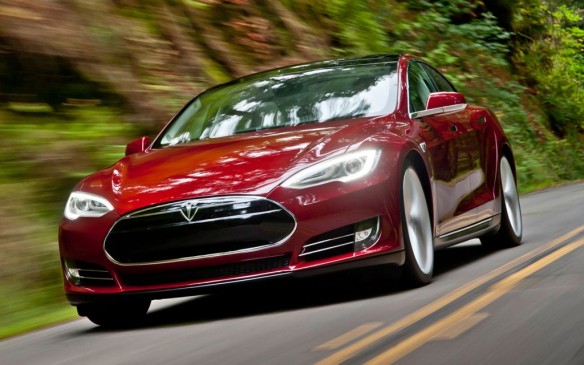
MYTH: EV’s are new…scary…future technology and cannot be trusted.
FACT: Electric vehicles are anything but scary and nothing new. The electric motor that moves them has only a few long lived moving parts and is a proven technology that has been used to make our lives easier since the mid-late 19 century.
They pre-date ICE powered vehicles and were hitting the roads of the world in the late 1800’s – see the timeline here: www.energy.gov/articles/history-electric-car
FACT: New technologies often have bugs that need to be worked out and then an adoption period before becoming mainstream. Examples: the light bulb, the toilet, the automobile, the air plane, the microwave, the personal computer, the cellular phone, the rocket ship…the electric car is no different and will see some setbacks but it is here to stay.

FACT: If your house or business is connected to the grid, and you or your company pays a power bill, then your, and most everyone’s houses/businesses are electric. Washer, dryer, refrigerator, freezer, stove and range, heating and cooling, lighting, entertainment systems, kitchen and many bathroom appliances, computers, mobile devices…electric…with many of these systems relying on electric motors and systems that quietly work in the background keeping our lives and the lives of our devices comfortable and functional. Why is it then that we continue to use outdated, noisy, toxic, leaky, high maintenance, complicated, petroleum powered transportation systems to get around on earth, in the water, and in the sky?
Part of the answer to the above question may be fear of change driven by a inate and often handed down complacency that many feel when they get set in their ways and comfortably used to any form of technology they have grown up with. To some, anything new, especially if it upsets the comfortable status quo, is seen as an invader that must be ignored and even stopped at all costs. I suppose not everyone can be an early adopter and game changer like Elon Musk. The final parts to the answer are the simply complicated politics and lots and lots of dirty money. In this recent article by Blue Ridge Electric Vehicle Club president Rudy Beharrysingh he states: The political implications of oil and gas are huge. Currently, the U.S. imports about 9.5 million barrels per day of oil. About 30 percent of this is from OPEC, with half of this from the Persian Gulf. That’s about 1.4 million barrels per day coming from the Persian Gulf. At a cost of $35 per barrel that is $50 million per day that we (consumers) send to the Middle East (on the order of $20 billion per year). And, that’s low compared to what it used to be. Need I say more…?
An eye opening Nissan Leaf commercial from a few years ago
The link: https://www.youtube.com/watch?v=pCs8B-TlylY
MYTH: “EV’s are slow like golf carts, dangerous, and I heard that they catch on fire and burn to the ground all the time.”
FACT: EV’s are anything but slow. The little Nissan Leaf EV will go 0-60 in around 10 seconds. The BMW i3 EV will do it in 7.2 and the Tesla Model S P85DL 100% electric car has the world record for the fastest accelerating production four-door car ever! It accelerates from 0 to 60 mph in a brain melting 2.6 seconds! Dangerous, totally the opposite – the Tesla Model S was rated by the NHTSA as the safest car ever tested…in history! If you want to see a Tesla Model S EV go against a Holden supercar take a look here:
Or if you would like to follow the link: www.youtube.com/embed/6eGhjhx8O9M?rel=0
Fires. According to the NFPA, cars catch fire on American highways once every two minutes. There were an average of 184,333 vehicle fires per year from 2008 to 2013. (I went back only to 2008 since it was the first year a highway-capable all-electric vehicle in serial production was available in the United States. That vehicle was the Tesla Roadster). Out of those 184,333 fires, less than a dozen of involved electric vehicles…ALL of the others were liquid fuel powered vehicles. There were an average of 1651 car fire injury and death victims every year from 2008-2013. In fact, due to fires involving liquid fueled vehicles 1765 people lost their lives during that timeframe. “The risk of a car or vehicle fire is even greater than the risk of an apartment fire. More people die in vehicle fires than in apartment fires each year in the United States,” said AAA President Robert Darblenet.

Burning Tesla Model S from
FACT: Electric vehicle fires are not a common occurrence in any way yet news agencies just love to manufacture drama. The fact that gas powered cars burn all the time is nothing new, it is not dramatic anymore…but let an EV catch fire (like one did recently in Norway – see: www.teslarati.com/tesla-model-s-burns-fire-supercharger-norway/ ) and it is all over the headlines because sensationalist drama centered around anything new and possibly politically controvercial feeds the weak minded. Note: I am not saying anyone reading this is weak minded because if you have read this far you obviously are interested in the facts and not the drama 🙂
More info on fires related to electric powered vehicles and other devices and systems can be found in this article and in this Wikipedia article.
Fact: electric vehicles present far less of a fire hazard than ICE powered vehicles.
Think of it like this: if everyone had been driving clean, fast, safe, low maintenance electric vehicles for the last century, and someone tried to get you to drive or even ride in a vehicle powered by an incredibly toxic, flammable, explosive, liquid fuel—what would you do? Personally, I would R.U.N.N.O.F.T!
Observation: Back before I drove an EV I was forced to periodically visit gas stations to fuel the subscription to dependency I had opted for when I purchased my gasoline powered vehicle. While filling up I often encountered people fueling their vehicle with the engines running, or even more astonishing – smoking while pumping gas. On these occasions I wanted to sit the people down and calmly warn them of the errors of their ways. I wanted to describe in detail the science behind their potentially very hazardous actions and the three times that I have had close calls with gasoline fueled vehicle fires that I offer up to you below –
Situation #1. Year 1986. My old Chevy truck would not start so I continued to give the engine more gas, the engine flooded, fuel leaked out of carburetor, a spark from a cracked spark plug wire ignited the fuel leak sending flames up and out of the engine bay melting all the rubber and plastic items under the hood. I put out the fire with a small fire extinguisher I kept under the seat and when it ran out I had to toss a jacket on the fire to finally put it out. If not for my fast thinking the vehicle would have burned to the ground and this would have caused me great peril.
Situation #2. Year 1991. Although not a road vehicle incident, I believe under the circumstances it still applies. My old lawn tractor was running rough. I took off the air filter housing and adjusted the carburetor to richen the mixture and it started running better. I then failed to replace air filter assembly. A few moments later the engine backfired through the carburetor sending a saber of flame straight up and into the old plastic fuel tank (that was soaked with fuel residue) which subsequently ignited into a ball of flame. This melted the fuel tank causing raw gasoline to cascade down onto engine and tractor like a flaming waterfall of peril. The tractor quickly began to burn to the ground. A passing off duty firetruck stopped to extinguish the tractor as it sat burning in middle of a field.
Situation #3. Year 2000. While my driving 1966 Land Rover up a steep highway grade, the vehicle’s cab suddenly filled with thick, acrid, white smoke and at the same time I smelled an intense gasoline smell!! I quickly pulled the vehicle off the road and bailed out running about 100 feet away leaving the engine running and door open for fear of meeting my ultimate demise! I watched from a distance as the smoke cleared from the cab of the still running vehicle and then a few seconds later the vehicle shut itself off as the fuel in the carbuerator ran out. I did not want to get near it for fear of whatever caused the issue possibly igniting a gas vapor explosion, fuel fire, and loads of deadly peril. After about 20 minutes of watching I decided that it was safe and carefully approached the vehicle. I soon discovered that the issue had been caused by faulty wiring. A wire had been routed around the fuel line and normal vehicle vibrations had caused the wire to abrade against the metal frame of vehicle creating an electrical short which burned all the insulation off of the wire causing the acrid smoke. The exposed red hot wire then melted through the plastic fuel line cutting it totally in half. Gasoline then poured out of the fuel line and all over the top of the fuel tank – yet somehow, no ignition had occurred. Talk about the luck of the Irish–it was with me that day. I would not be writing this if the gas fumes had ignited. If that had happened, the cab would have become an instant inferno, and both fuel tanks, that were 1/2 full or less and located under the driver and passenger seats, would have possibly ignited killing me in a flaming fuel fire worthy of dramatic news worthy sensationalism.
So you might say I am somewhat qualified, or at least have some life experience in the area of what can happen when gasoline and an ignition source are brought together. You could also say that I have the obligation to inform people of the error of their ways when I see them ignoring common sense and the warning labels posted all over the gasoline and diesel fueling station’s liquid fuel pumping machines. However, I also know from past experience that when I try to help others by offering friendly advice on the subject, I have always been met by rude comments like “mind your own business”, “it’s a free country” or “#!@! off!!”…so, since these people apparently either are; totally ignorant and/or do not understand the science behind the reality of the situation, have a death wish, or just do not care at all about their own safety or the safety of the other human beings that may be nearby. So, now whenever I encounter these situations I always report these individuals to the fueling station attendants and then I get away from the area as fast as possible because highly flammable liquid fuels + the increased potential for static/spark/flame induced fuel vapor ignition + careless, know-it-all or ignorant humans = loads of peril and Darwin awards just waiting to happen.

New kid on the block – the Chevrolet Bolt 200+ mile range EV
MYTH: Electric vehicles are expensive.
FACT: While it is true that a new Tesla Model S P85D will set you back over 100K, you can get into a new EV such as the Nissan Leaf and soon to be available Chevy Bolt and Tesla Model 3 for less than $35k. You must also remember to factor in that you will NEVER pay for gas/diesel and oil again and that in itself adds up to thousands of dollars/year…even when you account for the cost of the electricity used to fuel your EV! Then, when then you factor in all the money spent on tune-ups and engine/transmission/exhaust system repairs for most ICE powered vehicles – all the savings add up to reveal that most EV’s are much more economical to own and drive than your average ICE powered vehicle.
MYTH: When the battery wears out a new battery will cost more than the car is worth.

Nissan Leaf battery photo from InsideEV’s
FACT: When an EV’s battery degrades to the point where it is no longer able to store enough energy to propel you in your daily commute, the battery can be easily replaced with a new one-it is as plug and play as the battery in your mobile device or cordless tool…only larger. Currently the cost for the Nissan Leaf battery is around $5500 so it is about the same as having a new engine and transmission replaced in a standard ICE vehicle. After the battery is replaced you essentially have a new car. I admit that price is a bit high (especially if you are a do-it-yourself mechanic) but when Tesla’s Gigafactory (goes online in a few years they will start turning out lithium ion battery packs that will drastically lower the costs of EV batteries across the board. ( Learn more here www.teslamotors.com/gigafactory )

The Tesla Gigafactory: Source Tesla
Note: all EV manufactures have excellent battery warranties/leasing options that serve to help new EV drivers “ease into” a better way to drive and are great incentives for adopting a this technology. Nissan for example, offers a battery warranty of 8 years/100,000 miles against defects and 5 years/60,000 miles against capacity loss – whichever comes first.
MYTH: A used EV battery cannot be used for anything and is toxic waste.
FACT: Used EV batteries can be recycled just like any battery but before that time comes they can be used in stationary power storage facilities, as back up generators when connected to the energy grid, homes, and businesses, and off-grid power stations especially when connected to renewable energy power systems. Nissan has recently partnered with Green Charge to repurpose Nissan Leaf batteries for stationary energy storage Learn more here:
And more here:
www.nytimes.com/2015/06/17/business/gm-and-nissan-reusing-old-electric-car-batteries.html?_r=0
and here
www.greencarreports.com/news/1093810_electric-car-batteries-what-happens-to-them-after-coming-out-of-the-car
MYTH: There is nowhere to charge an EV?
FACT: Most EV drivers charge their cars at home overnight with the dealer supplied standard equipment charging cord that allows the car to be plugged into any 110v outlet. Many drivers have faster Level 2 charging units installed in their homes so they can charge up even faster.
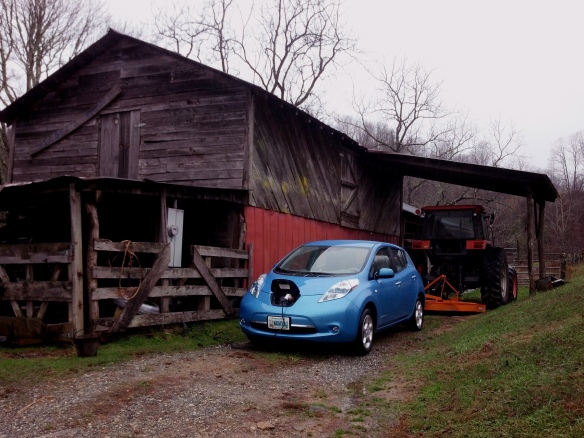
Plugged in and charging at a friend’s barn.
When out on the road there are over 25 thousand EV charging stations in the USA alone and the number is growing every day. To find out how many are near you just take a look at www.plugshare.com.
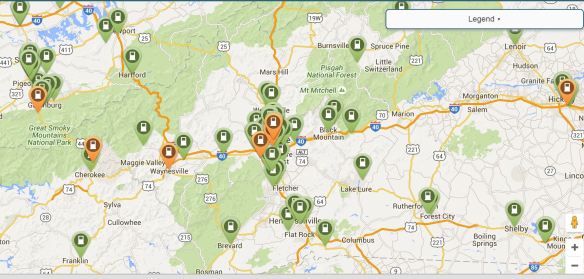
A screen capture of the close to 100 public charging stations in the WNC area from www.Plugshare.com
MYTH: Charging an EV is SLOW!
FACT: While not as fast as filling up the fuel tank EV charging is getting faster every day. Currently there are three levels of charging for most EV’s.
Level 1. AKA Trickle Charge. This is the method of charging that most EV owners use to fuel their vehicles while they sleep. The car comes with a charging cable with J1772 SAE plug that will fill the battery at the rate of 5-7 miles of range added per hour.
Level 2. This method of charging, that also uses the J1772 SAE plug, can be found at most of the publicly avaliable charging stations in cities and towns. These units are often found near shopping centers, movie theatres, resturants and downtown areas and will fill up an EV in 1-4 hours depending on how low the vehicle’s battery was upon plugging in. These units can be installed in your garage at home and there are some portable models as well.
Level 3. The fastest method of charging a fast charge capable EV. Using dedicated fast charging equipment and CHAdeMO or CCS equipped EV can be charged to 80% capacity in as little as 20 minutes!
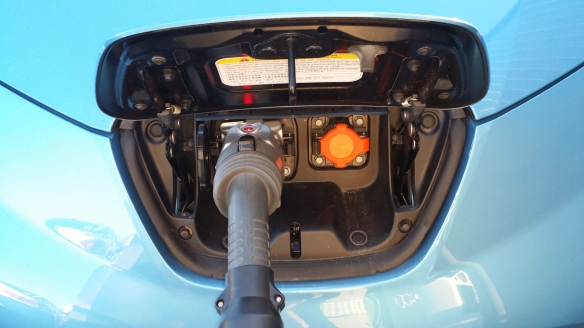 Plugged into a fast charger
Plugged into a fast charger
FACT: Most EV owners love their cars so much that they have become “crusaders” of the technology and promote them every chance they get because they know from experience that that they are a much better way to drive.

The Bluewater Leaf in the Blue Ridge Mountains of WNC far from any charging outlet
CONCLUSION
OPINION supported by SCIENCE, RESEARCH, and EXPERIENCE: All of these reasons and more are why EV’s are superior to everything else on the road and one day in the near future gas/diesel will go the way of the old fossils that power them. (this is not only my honest and humble opinion proven by science, research and experience but it is also been documented by the owners of EV’s everywhere in articles like these and more:
www.consumerreports.org/cro/cars/tesla-model-s-p85d-earns-top-road-test-score
www.ibtimes.co.uk/most-british-teenagers-expect-their-first-car-be-electric-1524811
FACT: Quoted from this Clean Technica article writen by Mike Barnard. “A tipping point has been reached in the last two years for electric cars. Almost half of all fully or partially electric vehicles sold in the past decade were sold in 2014. In addition to the standard-bearing Tesla, every car manufacturer in the world has fully or partially electric cars in their lineups. The most exciting cars in the world are now electric.”
FACT supported OPINION: Driving ICE powered vehicles is like purchasing a subscription to dependency on a highly toxic, highly addictive drug that shortens your life while constantly draining your bank account and damaging everything it comes in contact with.
Be the change you wish to see in the world and the world will change….or do nothing and nothing will ever change…it is your choice.
————————————————————
Special Thanks to Bob Harris of Black Bear Solar Institute for compiling many of the facts in this document! Learn more at: blackbearsolarinstitute.org
Special Thanks to the members of the Blue Ridge Electric Vehicle Club for supporting the future of transportation and renewable energy technologies.
* Parts replaced under warranty included one shock absorber, 1 strut, grease for the power window actuators, and two suspension bushings – all of these things are not EV specific and are commonly replaced/repaired items on all road vehicles. Non-warranty covered and non-user replaceable parts that needed replacement due to age/wear = Tires and brake fluid. Total cost = $610.
** Oil change only parts I have purchased for the 4Runner over the last 30k miles – several gallons of GOil and several Oil Filters = $230. Had I included all of the other parts I have replaced myself on the 4Runner over the same time-frame – the costs would have been well over $800! (If I had included the non-user replaceable parts and labor I have given to Larry at the auto repair shop then add another $1200!!!)
Total parts cost to operate Nissan Leaf for $30k miles = $665
Total parts cost to operate 4Runner for 30K miles = $2000
While I am aware that the 4Runner has over 6 times the mileage as the Leaf, the point remains that I have spent over 3X as much money on just parts to keep it on the road during the same period of time so…
After “Godzilla” the 4Runner dies, I will never go back to gas.

Plug into the future!




